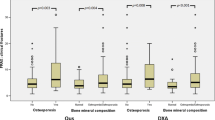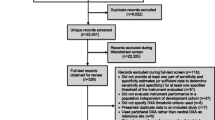Abstract
The aim of the study is to assess the sensitivity and specificity of different techniques and their ability to act as screening tools in relation to dual energy X-ray absorptiometry (DXA) in a group of 208 postmenopausal women. In this study we examined eight screening systems for the diagnosis of osteoporosis, the osteoporosis self-assessment tool (OST), the osteoporosis risk assessment instrument (ORAI), the osteoporosis index of risk (OSIRIS), a risk index derived using data from the study of osteoporotic fractures (SOFSURF), the simple calculated osteoporosis risk estimation (SCORE), patient body weight (pBW), along with two ultrasound based systems, the Sunlight Omnisense (Sunlight Medical, Rehovot, Israel) and the CUBA Clinical (McCue plc, Winchester, UK). The sensitivity and specificity of the different techniques in relation to DXA were plotted as receiver-operating characteristic (ROC) curves at three different levels (DXA T-score −2.5 osteoporosis, −2 and −1 osteopenia). The areas under the curves (AUC) were calculated and showed broadband ultrasound attenuation (BUA) at the calcaneus to provide consistently the highest AUC (0.77–0.81). The velocity of sound (VOS) of the calcaneus (AUC =0.72–0.76) was equally good, but was out-performed by some of the questionnaire systems (AUC =0.66–0.79). Both the questionnaire systems and the CUBA Clinical out-perform the Sunlight Omnisense (AUC =0.58–0.7), which showed comparable performance with body weight (AUC =0.66–0.69). The results show that QUS is capable of selecting patients with low bone density as measured by DXA. A patient displaying a low QUS value should be followed up with a DXA scan to confirm the diagnosis.


Similar content being viewed by others
References
Geusens P, Hochberg MC, van der Voort DJM, et al (2002) Performance of risk indicies for identifying low bone density in postmenopausal women. Mayo Clin Proc 77:629–637
Koh LKH, Sedrine WB, Torralba TP, et al (2001) A simple tool to identify asian women at increased risk of osteoporosis. Osteoporos Int 12:699–705
Fujiwara S, Masunari N, Suzuki G, et al (2001) Performance of osteoporosis risk indices in a Japanese population. 62:586–594
Adler RA, Tran MT, Petkov VI (2003) Performance of the Osteoporosis Self-assessment Screening Tool for osteoporosis in American men. Mayo Clin Proc 78:723–727
Kung AWC, Ho AYY, Sedrine WB, et al (2003) Comparison of a simple clinical risk index and quantitative bone ultrasound for identifying women at increased risk of osteoporosis. Osteoporos Int 14:716–721
Richy F, Gourlay M, Ross PD, et al (2004) Validation and comparative evaluation of the Osteoporosis Self-Assessment Tool (OST) in a Caucasian population from Belgium. Q J Med 97:39–46
Park HM, Sedrine WB, Reginster JY, et al (2003) Korean experience with the OSTA Risk Index for Osteoporosis. J Clin Densitom 6:247–250
Cadarette SM, Jaglal SB, Kreiger N, et al (2000) Development and validation of the Osteoporosis Risk Assessment Instrument to facilitate selection of women for bone densitometry. Can Med Assoc J 162:1289–1294
Von Mühlen D, Lunde AV, Barrett-Connor E, et al (1999) Evaluation of the Simple Calculated Osteoporosis Risk Estimation (SCORE) in older Caucasian women: The Rancho Bernardo Study. Osteoporos Int 10:79–84
Sedrine WB, Devogelaer JP, Kaufman JM, et al (2001) Evaluation of the Simple Calculated Osteoporosis Risk Estimation (SCORE) in a sample of White women from Belgium. Bone 29:374–380
Cadarette SM, Jaglal SB, Murray TM (1999) Validation of the Simple Calculated Osteoporosis Risk Estimation (SCORE) for patient selection for bone densitometry. Osteoporos Int 10:85–90
Falasca GF, Dunston C, Banglawala YA (2003) Further validation of a questionnaire to identify women likely to have low bone density. J Clin Densitom 6:231–236
Ungar WJ, Josse R, Lee S, et al (2000) The Canadian Score Questionnaire. J Clin Densitom 3:269–280
Sedrine WB, Chevallier T, Zegels B, et al (2002) Development and assessment of the Osteoporosis Index of Risk (OSIRIS) to facilitate selection of women for bone densitometry. Gynecol Endocrinol 16:245–250
Reginster JY, Sedrine WB, Viethel P, et al (2004) Validation of OSIRIS, a prescreening tool for the identification of women with an increased risk of osteoporosis. Gynecol Endocrinol 18:3–8
Black DM, Steinbuch M, Palermo L, et al (2001) An assessment tool for predicting fracture risk in postmenopausal women. Osteoporos Int 12:519–528
Randell AG, Bhalerao N, Nguyen TV, et al (1998) Quality of life in osteoporosis: reliability, consistency, and validity of the Osteoporosis Assessment Questionnaire. J Rheumatol 25:1171–1179
Gerber V, Krieg MA, Cornuz J, et al (2003) Nutritional status using the Mini Nutritional Assessment Questionnaire and its relationship with bone quality in a population of institutionalized elderly women. J Nutr Health Aging 7:140–145
Goemaere S, Zegels B, Toye K, et al (1999) Limited clinical utility of a self-evaluating risk assessment scale for postmenopausal osteoporosis: lack of predictive value of lifestyle-related factors. Calcif Tissue Int 65:354–358
Michaëlsson K, Bergström R, Mallmin H, et al (1996) Screening for osteopenia and osteoporosis: selection by body composition. Osteoporos Int 6:120–126
Greenhalgh T (1997) How to read a paper: papers that report diagnostic or screening tests. BMJ 315:540–543
Glas AS, Lijmer JG, Prins MH, et al (2003) The diagnostic odd ratios: a single indicator of test performance. J Clin Epidemiol 56:1129–1135
Grimes DA, Schulz KF (2002) Uses and abuses of screening tests. Lancet 359:881–884
Swets JA (1988) Measuring the accuracy of diagnostic systems. Science 240:1285–1293
Leib ES, Lewiecki EM, Binkley N, et al (2004) Official positions of the international society for clinical densitometry. J Clin Densitom 7:1–6
Greenspan SL, Bouxsein ML, Melton ME, et al (1997) Precision and discriminatory ability of calcaneal bone assessment technologies. J Bone Miner Res 12:1303–1313
Brooke-Wavell K, Jones PR, Pye DW (1995) Ultrasound and dual X-ray absorptiometry measurement of the calcaneus: influence of region of interest location. Calcif Tissue Int 57:20–24
Johansen A, Evans W, Stone M (1999) Bone assessment in elderly women: what does a low bone ultrasound result tell us about bone mineral density? Arch Gerontol Geriatr 28:239–246
Njeh CF, Hans D, Li J, et al (2000) Comparison of six calcaneal quantitative ultrasound devices: precision and hip fracture discrimination. Osteoporos Int 11:1051–1062
Herd RJM, Blake GM, Miller CG, et al (1994) The ultrasonic assessment of osteopenia as defined by dual X-ray absorptiometry. Br J Radiol 67:631–635
Graafmans WC, Lingen AV, Ooms ME, et al (1996) Ultrasound measurements in the calcaneus: precision and its relation with bone mineral density of the heel and the lumber spine. Bone 19:97–100
Knapp KM, Blake GM, Spector TD, et al (2001) Multisite quantitative ultrasound: precision, age- and menopause- related changes, fracture discrimination, and t -score equivalence with dual-energy X-ray absorptiometry. Osteoporos Int 12:456–464
Damilakis JE, Papadokostakis G, Vrahoriti H, et al (2003) Ultrasound velocity through the cortex of phalanges, radius, and tibia in normal and osteoporotic postmenopausal women using a new multisite quantitative ultrasound device. Invest Radiol 38:207–211
Nicholson PHF, Strelitzki R, Cleveland RO, et al (2000) Scattering of ultrasound in cancellous bone: predictions from a theoretical model. J Biomech 33:503–506
Stewart A, Reid DM (2000) Quantitative ultrasound or clinical risk factors—which best identifies women at risk of osteoporosis? Br J Radiol 73:165–171
Adler RA, Funkhouser HL, Holt CM (2001) Utility of heel ultrasound bone density in men. J Clin Densitom 4:225–230
Ekman A, Michaëlsson K, Petrén-Mallmin M, et al (2002) Dual X-ray absorptiometry of hip, heel ultrasound, and densitometry of fingers can discriminate male patients with hip fractures from control subjects. J Clin Densitom 5:79–85
Sørensen HA, Jørgensen NR, Jensen J-EB, et al (2001) Comparison of quantitative ultrasound and dual X-ray absorptiometry in estrogen-treated early postmenopausal women. J Clin Densitom 4:97–104
Falgarone G, Porcher R, Duché A, et al (2004) Discrimination of osteoporotic patients with quantitative ultrasound using imaging or non-imaging device. Joint Bone Spine (corrected proof)
Damilakis JE, Papadokostakis G, Perisinakis K, et al (2003) Can Radial bone mineral density and quantitative ultrasound measurements reduce the number of women who need axial density skeletal assessment? Osteoporos Int 14:688–693
Knapp KM, Blake GM, Spector TD, et al (2004) Can the WHO definition of osteoporosis be applied to the multi-site axial transmission quantitative ultrasound? Osteoporos Int 15:367–374
Gambacciani M, de Aloysio D, Elia D, et al (2003) Quantitative ultrasound (qus) of bone in the management of postmenopausal women. Maturitas 47:139–149
Hans D, Hartl F, Krieg MA (2003) Device-specific weighted T-score for two quantitative ultrasounds: operational proportions for the management of osteoporosis for 65 years and older women in Switzerland. Osteoporos Int 14:251–258
Acknowledgements
Support has been provided by the UK Department of Transport under the BOSCOS project, which allowed us to gain access and make use of the Sunlight Omnisense and CUBA Clinical systems. Special thanks are due to all members of the Department of Radiology of GWH in Swindon for their generous help with this study.
Author information
Authors and Affiliations
Corresponding author
Rights and permissions
About this article
Cite this article
Cook, R.B., Collins, D., Tucker, J. et al. Comparison of questionnaire and quantitative ultrasound techniques as screening tools for DXA. Osteoporos Int 16, 1565–1575 (2005). https://doi.org/10.1007/s00198-005-1864-x
Received:
Accepted:
Published:
Issue Date:
DOI: https://doi.org/10.1007/s00198-005-1864-x




